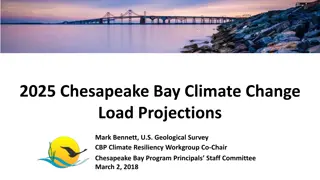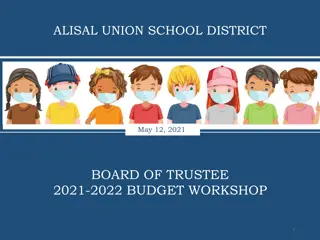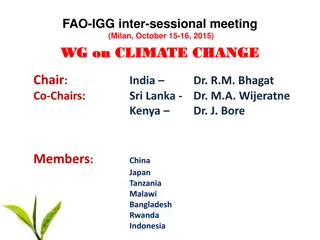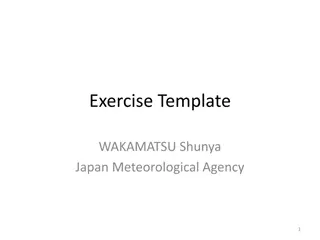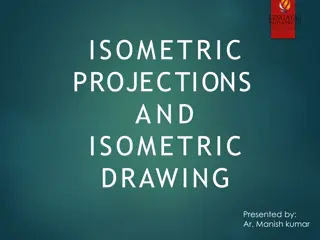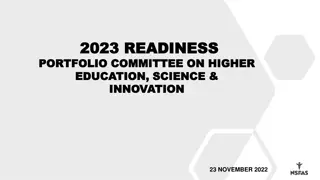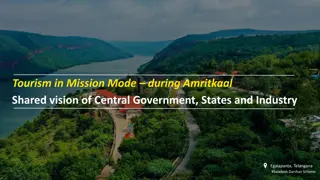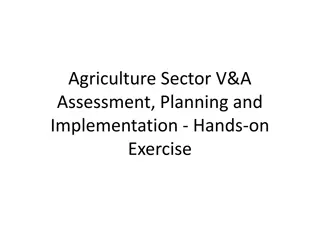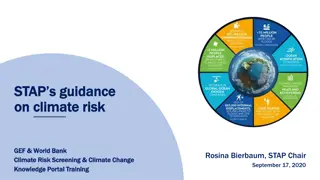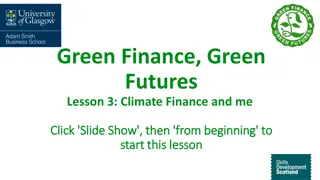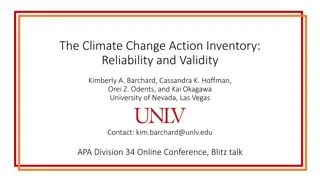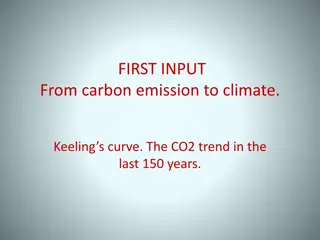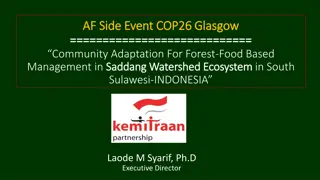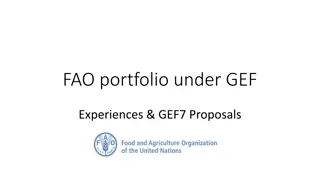Understanding Climate Projections for Impact Assessment
The Climate Futures Framework provides insights into using climate projections for impact assessments, emphasizing the importance of tailoring projections to specific objectives. Typical climate projections involve central tendencies and uncertainty ranges, but assessing multiple variables jointly requires a more nuanced approach. Internal consistency in climate projections is crucial, highlighting the need to move beyond just mean and range estimates.
- Climate Projections
- Impact Assessment
- Climate Futures Framework
- Uncertainty Management
- Internal Consistency
Download Presentation

Please find below an Image/Link to download the presentation.
The content on the website is provided AS IS for your information and personal use only. It may not be sold, licensed, or shared on other websites without obtaining consent from the author. Download presentation by click this link. If you encounter any issues during the download, it is possible that the publisher has removed the file from their server.
E N D
Presentation Transcript
Introduction to the Climate Futures Framework John Clarke, Tim Erwin
Impact Assessment Climate projections are used in a variety of impact assessments The level of detail depends on the objectives of the decision-makers, e.g. less detail is required for general awareness-raising than designing a new road Not one size fits all , so climate projections need to be purpose-built Because of the uncertainty, often use a risk management approach to evaluate important cases , e.g. Best Case Worst Case Maximum Consensus Case (if there is one) } }?
Typical climate projections Typically projections are for individual climate variables for selected years and emissions scenarios Projections expressed as a central tendency (e.g. mean or median) with a range of uncertainty, e.g. 2 C (1-3 C) warmer 10% (5-15%) wetter OK for general information and working with single climate variables, but... What if your impact assessment needs to consider multiple variables jointly (e.g. crop growth, species distributions)?
Typical climate projections & Internal Consistency Temperature change: +1.7 (+1.1 to +2.6) C Rainfall change: -2.4 (-15.0 to +12.9) %
Typical climate projections & Internal Consistency Temperature change: +1.7 (+1.1 to +2.6) C Rainfall change: -2.4 (-15.0 to +12.9) % Temperature Rainfall
Typical climate projections & Internal Consistency Temperature change: +1.7 (+1.1 to +2.6) C Rainfall change: -2.4 (-15.0 to +12.9) % But you know none of this if all you have is a mean and range!
Typical climate projections & Internal Consistency Temperature change: +1.7 (+1.1 to +2.6) C Rainfall change: -2.4 (-15.0 to +12.9) % Temperature Rainfall
Typical climate projections & Internal Consistency Temperature change: +1.7 (+1.1 to +2.6) C Rainfall change: -2.4 (-15.0 to +12.9) % Temperature 1. This combination is not simulated by any model, and 2. it only represents a tiny subset of all the possibilities 3. How can we obtain internally consistent data and also adequately sample the range of model results? Rainfall
What do we want from the projections? Internally Consistent Data Adequately Sample the Range Achievable Information on Model Agreement (> likelihood) Credibility (model evaluation)
Using individual models for impact assessment every model Climate Model 1 Impact Model Assessment 1 Synthesis and Evaluation Climate Model 2 Impact Model Assessment 2 Climate Model 3 Impact Model Assessment 3 Climate Model 4 Impact Model Assessment 4 ........ ........ ........ Climate Model 40 Impact Model Assessment 40
What we want from projections - using every model ? Internally Consistent Data Adequately Sample the Range Achievable Information on Model Agreement
Using individual models for impact assessment Best model approach Synthesis and Evaluation Climate Model 1 Impact Model Assessment 1 Climate Model 2 Impact Model Assessment 2 Climate Model 3 Impact Model Assessment 3
What we want from projections - best models ? Internally Consistent Data Adequately Sample the Range Achievable Information on Model Agreement
Start with what the models say... An alternative approach
Climate Futures approach Work with the decision-makers, identify: Current sensitivity (what climate variables impact on the suitability of infrastructure): Key Cases Best: future with highest rainfall and least evaporation Worst: future with lowest rainfall and highest evaporation Maximum Consensus (if possible) or Mid-range Use Representative Model Wizard to identify models to appropriately represent each Key Case Draw on existing information on model skill
Key Cases Best case Maximum Consensus Worst case
Using the results in an impact assessment Representative Model Case Climate Future Consensus Best Hotter, Wetter Very Low NorESM1-ME Much Hotter, Much Drier Worst Low IPSL-CM5A-LR Maximum Consensus Hotter, Much Drier Moderate HadGEM2-ES Obtain required data from each model From CCiA website (incl. GCM, downscaled, maps, GIS, time-series) NARCliM, Climate Futures Tasmania, Goyder Institute Other sources (e.g. Tyndall Centre, CliMond) Contact us Run assessment for each model to evaluate each case Use model consensus information to assist weighing up likelihoods of each case
Using individual models for impact assessment key cases: Climate Futures Best Case (with model consensus information) Synthesis and Evaluation Climate Model 1 Impact Model Assessment 1 Worst Case (with model consensus information) Climate Model 2 Impact Model Assessment 2 Maximum Consensus Case Climate Model 3 Impact Model Assessment 3
What we want from projections - key cases from Climate Futures Internally Consistent Data Adequately Sample the Range Achievable Information on Model Agreement Whether using a subset or all models
Further Information The conceptual and scientific basis of the Climate Futures Framework Whetton P, Hennessy K, Clarke J, McInnes K, Kent D (2012) 'Use of Representative Climate Futures in impact and adaptation assessment.' Climatic Change 115, 433-442. 10.1007/s10584-012-0471-z. Application of the Climate Futures Framework Clarke JM, Whetton PH, Hennessy KJ (2011) 'Providing Application-specific Climate Projections Datasets: CSIRO s Climate Futures Framework.' Peer-reviewed conference paper. In F Chan, D Marinova and RS Anderssen (eds.) MODSIM2011, 19th International Congress on Modelling and Simulation. Perth, Western Australia. December 2011 pp. 2683-2690. ISBN: 2978-2680-9872143-9872141-9872147. (Modelling and Simulation Society of Australia and New Zealand). http://www.mssanz.org.au/modsim2011/F5/clarke.pdf. Climate Change in Australia Online Training: Module 4 The Climate Futures Framework https://www.climatechangeinaustralia.gov.au/en/climate-campus/online-training/climate-futures-framework/ Climate Change Animations (including one on Australian Climate Futures) https://www.climatechangeinaustralia.gov.au/en/support-and-guidance/tools-communicators/communication- resources/animations/
CONTACT US CCIA Team CSIRO Climate Science Centre e: climatefutures@csiro.au w: www.csiro.au




